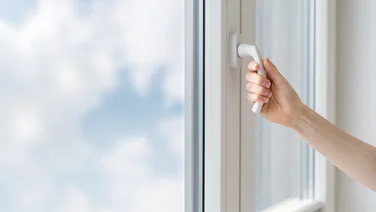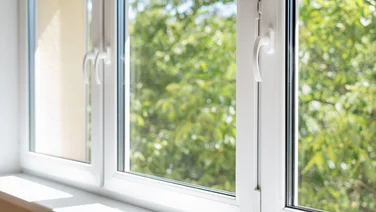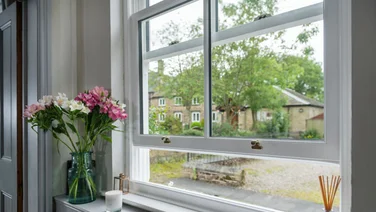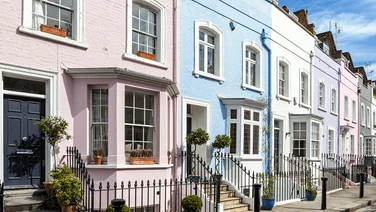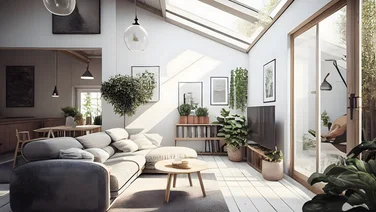We receive a small fee from trusted installers when you request a quote through our site. This helps us keep our content independent, well-researched and up to date – Learn more
- What are tilt and turn windows?
- How much do tilt and turn windows cost?
- The different types of tilt and turn window
- The pros and cons of tilt and turn windows
- Are tilt and turn windows right for your property?
- How long do tilt and turn windows take to install?
- Do tilt and turn windows require much maintenance?
- Are tilt and turn windows worth it?
- Next steps
- Tilt and turn windows: FAQs
- Tilt and turn windows can improve a property’s energy efficiency and security
- They come in a variety of materials including PVC, wood, and aluminium
- Tilt and turn windows are more expensive than traditional ones

Although double glazed window costs can be pretty high, they’re a key part of every home, bringing in light and fresh air – and tilt and turn windows offer plenty of benefits that you can’t get from traditional windows.
In this article we explore the pros and cons of tilt and turn windows, and whether they could be the right fit for your home.
Looking into double glazing? You can easily compare the best prices by filling out your details in our easy-to-use quote tool. Our trusted suppliers will get in touch with you with free quotes for you to compare.
What are tilt and turn windows?
Tilt and turn windows have a design that provides two distinct opening modes. They were first engineered in Germany in the 1950s, and their flexibility has made them popular in the UK.
In tilt mode, the window sash is hinged at the bottom and can be tilted inward from the top. This allows for controlled ventilation while maintaining a degree of security since the opening is limited.
If you’re interested in finding the best double glazing companies in the UK, read our guide. Also, if you want to know how much new windows might set you back, look at our double glazing cost calculator.
In turn mode, the window sash can be swung outwards like a traditional window, allowing for a larger opening that facilitates easy cleaning and maximum ventilation.
How much do tilt and turn windows cost?
| 800x800mm | 1000mmx1000mm | 1200mmx1200mm | |
|---|---|---|---|
PVC | £280 | £380 | £405 |
Wood | £330 | £400 | £430 |
Aluminium | £540 | £650 | £770 |
As you can see from the table above, the cost of double glazed windows varies depending on the material the windows are made from. As well as the costs for the windows themselves, you will also need to budget for the installation by a professional. The cost can vary from around £180-£250 per window.
Taking wood, the middle priced material as an example, if you wanted eight 1000mmx1000mm tilt and turn windows, these would cost £3,200 excluding installation. For installation, let’s take the middle amount of £210 per window, the installation would cost £1,680. In total, the cost you’d need to budget for would be £4,880.
Of course, there will be more affordable options on the market, but they won’t be very durable. You can find out more about this on our guide Should You Buy Cheap Double Glazed Windows?
If you’re interested in double-glazing grants for over-60s, have a look at our guide.
The different types of tilt and turn window
While the basic operation of tilting and turning remains consistent, the aesthetics and features can vary. Here are some different types:
uPVC: uPVC windows are the most common type of tilt and turn windows, offering a modern appearance and costing less than other materials, making them suitable for many properties.
Wood: Some people prefer the warm aesthetic of timber. Wooden windows provide a traditional look and can be well-suited for certain types of architecture but are more expensive than PVC.
Aluminium: This material is known for its sleek and contemporary appearance. It’s lightweight, strong, and resistant to corrosion, making it suitable for modern designs. Aluminium windows tend to be more expensive than PVC and wood.
For more information on aluminium double glazed windows, read our dedicated page.
Arched or curved: Some manufacturers offer tilt and turn windows in arched or curved shapes to add a touch of uniqueness. These can be particularly appealing in homes with specific architectural styles.
Double or triple glazed: These windows – particularly triple glazed windows – are a great choice for areas with extreme weather conditions or noise pollution.
Custom: Some manufacturers offer customisation options, allowing you to choose different colours, finishes, hardware, and grid patterns to match your design preferences.
Safety: Some tilt and turn windows come with enhanced safety features, such as childproof locks or restricted opening options – particularly beneficial for families with young children.
The pros and cons of tilt and turn windows
- Secure ventilation – prevents unwanted access while allowing air circulation
- Energy efficient – when closed they provide a tight seal, improving insulation
- Space efficiency – practical in areas where outward-opening windows might not be feasible due to limited outdoor space
- Enhanced security – often feature multipoint locking systems
- More expensive – tilt and turn windows tend to cost more upfront than traditional windows
- Installation – proper installation by professionals is crucial for these windows to function correctly, adding more to the upfront cost
- Availability – tilt and turn windows are less common in some areas and may not be as easy to purchase
Overall there are more pros than cons for tilt and turn windows. However the cost is a big factor and is likely to put some people off investing in them. Availability of this type of window could also make it harder to source than traditional windows.
Are tilt and turn windows right for your property?
Determining whether tilt and turn windows are right for your property involves considering various factors. Here are some questions to answer in order to figure out whether they’re suitable for you.
- Do you value the ability to control ventilation and have both a smaller tilting opening and a larger fully open option? Tilt and turn windows excel in offering versatile ventilation options.
- Is energy efficiency important to you? Tilt and turn windows, when closed and locked, create a tight seal that contributes to better insulation and reduced energy costs.
- Do you prioritise security? Tilt and turn windows often come with advanced locking mechanisms and can be particularly secure when in the fully closed and locked position.
- Do the aesthetics of tilt and turn windows fit well with the architectural style of your property? Consider whether they complement your home’s design.
- Do you have limited outdoor space or obstacles outside the window that would make outward-opening windows impractical? Tilt and turn windows are ideal for such situations.
- Are you prepared for the higher upfront cost associated with tilt and turn windows? Consider your budget and whether the benefits outweigh the initial investment.
- What’s your local climate like? Tilt and turn windows can be well-suited for areas with varying weather conditions.
It’s a good idea to consult with window professionals who can provide expert advice based on your property’s characteristics and your specific needs. They can help you understand how tilt and turn windows would integrate with your home and whether they are the right choice.

How long do tilt and turn windows take to install?
The installation time for tilt and turn windows can vary. For example, full-frame replacement (removing the entire existing window frame) might take longer than retrofitting (installing the new window within the existing frame).
Unsurprisingly, the more windows being installed, the longer the installation process will take. Plus, more time may be required for larger or more intricate windows, or those with specific customisations.
On average, a standard tilt and turn window installation for a single window could take around 2 to 4 hours. However, it’s important to consult with the window supplier or installer directly for a more accurate estimate based on your home.
Do tilt and turn windows require much maintenance?
Tilt and turn windows are generally considered to be low maintenance. However, they still require some level of looking after to ensure they function properly and remain in good condition.
Regularly cleaning the glass, frames, and hardware is important to maintain the appearance and functionality of your windows. Ideally you would periodically lubricate the hinges, handles, and locking mechanisms to ensure smooth operation.
If you have wooden tilt and turn windows, they might require repainting or refinishing to protect the wood from the elements.
Over time, the hardware and mechanisms might require adjustments to ensure proper operation, or if you notice condensation between the glass panes (for double or triple glazed windows), it could indicate a broken seal. In these instances, it might be time to call in a professional.
Are tilt and turn windows worth it?
There are definitely many benefits to having tilt and turn windows, however there’s several things to consider about whether they are a good investment for you.
If you value energy efficiency, then tilt and turn windows tend to be better for insulation with their airtight seal. This could provide some payback in terms of bringing your energy bills down in the future. They’re also a very good option if you lack space outside but still want to be able to have fresh airflow into your home, as they open inwards.
The main factor which could be a barrier is the cost – tilt and turn windows are more expensive than traditional windows. And because they require professional installation, which can take longer because of the windows being more complex, this also needs to be factored into your budget.
Tilt and turn windows might be less common in certain regions too, which could affect availability and installation services.
Ultimately, the decision to invest in tilt and turn windows depends on your priorities. If you value features like versatile ventilation, energy efficiency, and enhanced security, tilt and turn windows could be a worthy investment. However, if the upfront cost is a concern or if the aesthetics don’t align with your home’s style, you might want to explore other options.
Next steps
We hope this article has provided you food for thought when considering tilt and turn windows for your home. There are certainly some good benefits but it comes down to whether you think they are worth the investment, and also how easily you can find this type of window where you live. We always advise speaking to a window professional as part of your research.
If you’re looking into double glazing in general, you can easily compare the best prices by filling out your details in our easy-to-use quote tool. Free quotes will be sent to you by our trusted suppliers.
Tilt and turn windows: FAQs
Are tilt and turn windows a good idea?
There are many benefits to tilt and turn windows including better energy efficiency, higher security, and a better alternative for properties lacking outdoor space. However they are more expensive than traditional windows, and can be harder to find.
Can you still get tilt and turn windows?
Yes you can, what’s more they come in a variety of shapes and sizes, as well as materials including PVC, wood, and aluminium, depending on what is most suitable for your property.
What are tilt and turn windows?
Tilt and turn windows have a design that provides two distinct opening modes. Tilt mode means the window sash is hinged at the bottom and can be tilted inward from the top. In turn mode, the window sash can be swung open like a door, like a traditional window.


